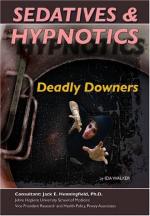|
This section contains 1,777 words (approx. 6 pages at 300 words per page) |

|
Sedatives are drugs that decrease activity and have a calming, relaxing effect. People use these drugs mainly to reduce anxiety. At higher doses, sedatives usually cause sleep. Drugs used mainly to cause sleep are called hypnotics. The difference between sedatives and hypnotics, then, is usually the amount of the dose—lower doses have a calming effect and higher doses cause sleep.
Currently, the most commonly prescribed sedatives are benzodiazepines, such as Valium. These drugs are also known as minor tranquilizers. Before the development of benzodiazepines in the 1950s and 1960s, doctors most often prescribed barbiturates to cause sleep and sedation. Because barbiturates have a high potential for abuse, doctors today rarely prescribe them. The exception is phenobarbital (Luminal), which is still used as a sedative and as an anticonvulsant.
Sedative-hypnotics can produce side effects in some people, especially the elderly and the...
|
This section contains 1,777 words (approx. 6 pages at 300 words per page) |

|


